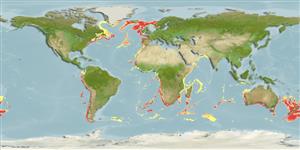Inhabits deep, cold waters over steep continental slopes, ocean ridges and sea-mounts. Shallow range of usual occurrence from Ref. 27121. Appears to be dispersed over both rough bottoms and steep, rough grounds where it feeds on crustaceans and fish. In New Zealand, the main prey include mesopelagic and benthopelagic prawns, fish, and squid, with other organisms such as mysids, amphipods and euphausiids occasionally being important (Ref. 9072). Juveniles feed mainly on crustaceans (Ref. 27075, 27076). Grows very slowly and is one of the longest lived fish species known. Based on parasite and trace-element analyses, orange roughy is a sedentary species with little movement between fish-management zones (Ref. 27089). Little is known of the larvae and juveniles which are probably confined to deep water (Ref. 27088). The fishery targets sporadically formed dense spawning and non-spawning aggregations. Marketed fresh and frozen; eaten steamed, fried, microwaved and baked (Ref. 9988). Because of severe overfishing the species has been listed as threatened by the Australian Government in 2006.
深地栖息于, 在陡峭的大陆斜坡,海洋脊与海底山脉上的寒冷水域。 平常发生的水浅范围从参考文献 27121. 似乎散居在两者的之上粗糙的底部与陡峭的, 粗燥的底部在那里它吃甲壳类动物和鱼类。 在纽西兰,主要的猎物包括中层带与大洋底栖性鱼种虾,鱼与乌贼, 与其它的生物在一起例如糠虾,片脚类动物与磷虾偶然地是重要的.(参考文献 9072) 稚鱼主要捕食甲壳动物。 (参考文献 27075,27076) 非常慢慢地生长而且是一那生命最长的被知道的鱼种。 以寄生虫与痕迹为依据-要素分析, 橘色的 roughy 是有小的在魚-管理的區域之間的運動的一個定棲的種.(參考文獻 27089) 少為人知仔魚與稚魚可能那是侷限於深水域.(參考文獻 27088) 漁場目標偶而形成了密集的產卵與非被產卵的群集。 在市場上銷售生鮮和冷凍; 清蒸, 油炸, 微波了而且燒烤了.(參考文獻 9988) 由於嚴重的捕撈過度此魚種已經被列出當在 2006 年受到威脅的由於澳洲的政府.
Preferred temperature (Ref.
115969): 3.5 - 8.4, mean 6.6 (based on 754 cells).
Phylogenetic diversity index (Ref.
82804): PD
50 = 0.5000 [Uniqueness, from 0.5 = low to 2.0 = high].
Bayesian length-weight: a=0.02239 (0.01607 - 0.03118), b=3.08 (2.98 - 3.18), in cm Total Length, based on LWR estimates for this species (Ref.
93245).
营养阶层 (Ref.
69278): 4.3 ±0.1 se; based on diet studies.
回复力 (Ref.
120179): 非常低的, 最小族群倍增时间超过14 年 (K=0.04-0.06; tm=5-33; tmax=140; Fec=10,000).
Prior r = 0.07, 95% CL = 0.05 - 0.11, Based on 3 full stock assessments.
Fishing Vulnerability (Ref.
59153): High to very high vulnerability (72 of 100).
Climate Vulnerability (Ref.
125649): Moderate to high vulnerability (54 of 100).
